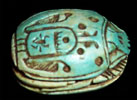

Khepri (Kheper, Khepera, Chepri, Khephir) was associated with the scarab or dung beetle (Scarabaeus sacer), making him one of the most famous insect gods. The Egyptians watched the scarab beetle rolling dung into a ball and pushing it along the ground to its burrow. The Egyptians made a connection between the movement of the sun across the sky and the movement of the ball of dung pushed by the beetle. The solar connection was enhanced by the fact that the scarab has antenna on its head and when the scarab pushed a ball of dung along the ground, the ball would sit between the antenna in a way that was reminiscent of the solar disc flanked by a pair of horns which was worn by many deities.
One myth suggested that Khepri pushed the sun across the sky (rather than the sun travelling on the back of a bovine goddess like Nut or Hathor or travelling on a boat). Khepri was often depicted pushing the sun ahead of him and it was thought that this movement was constant. Every night, Khepri would push the sun down into the underworld, and every morning the sun would again emerge and travel across the sky. The word “kheper” means “to emerge” or “to come into being”.
The female scarab would lay her eggs in the burrow with the dung and her young would feed on the dung until they were ready to emerge. The Egyptians, however, believed that the young scarab emerged spontaneously from the burrow as if created from nothing. Thus, like Atum, he was a self-created god. The scarab beetle also lays its eggs in carrion, leading the ancient Egyptians to speculate that those scarab beetles were created from dead matter. As a result, Khepri was strongly associated with rebirth, renewal, and resurrection.

He was given a central role in the “book of the dead” (“the book of coming forth by day”) and the “amduat” (“the book of that which is in the underworld” or “the book of the secret chamber”) and scarab amulets were placed over the heart of the deceased during the mummification ritual. These “heart scarabs” were meant to be weighed against the feather of Ma’at (truth) during the final judgement. Scarabs were often inscribed with a spell from the Book of the Dead which instructed their heart .. “do not stand as a witness against me.”

Khepri was soon seen as an aspect of the sun itself, in particular the sun at daybreak – when it “emerged” from the underworld. He was closely associated with Atum (the creator god), Nefertum (literally “young Atum” or “beautiful Atum”) and Ra (who absorbed many of Atum’s attributes). Khepri was the emerging sun, Nefertum was the new born sun, Ra was the sun during the day, and Atum was the setting sun. In later funerary texts, Atum and Khepri merged into a ram-headed beetle who was the ultimate expression of the power of life over death.
He is first mentioned in the Pyramid Texts but may well have been well known for some time before that because crude scarabs have been recovered which date from the Neolithic period (7000-5000 BC). Khepri’s popularity was at its height during the New Kingdom.
No temple or cult has been discovered which was specifically dedicated to Khepri, but it is thought that the majority of Egyptian temples (possibly all temples) had a statue of Khepri inside them. The scarab amulet was one of the most popular symbols and scarabs were inscribed for all occasions, not just for use in mummification, confirming that he was popular with the common people. He was also popular with royalty, and many pharaohs incorporated his name into their own.
Khepri was usually depicted as a scarab beetle but occasionally appears as a man with the head of a scarab. There are numerous depictions of Khepri pushing the sun before him and he also appears regularly in a funerary setting riding on a sun barque as he travels through the underworld. Because of his connection with rebirth and the underworld, he occasionally wears the atef crown of Osiris.
Copyright J Hill 2010